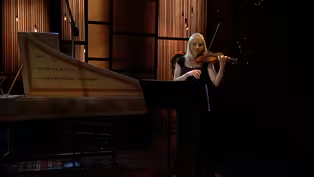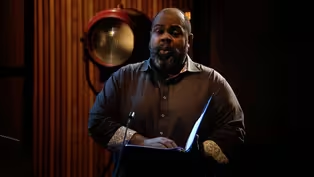11th and Grant
The Baroque Violin
Clip: Season 14 Episode 6 | 5m 4sVideo has Closed Captions
Carrie Krause discusses her Baroque violin.
Carrie Krause, violinist and founder of Baroque Music Montana, discusses the differences between a Baroque and contemporary violin.
Problems playing video? | Closed Captioning Feedback
Problems playing video? | Closed Captioning Feedback
11th and Grant is a local public television program presented by Montana PBS
11th and Grant is proudly supported by The Greater Montana Foundation, The Gilhousen Family Foundation, Montana State University, office of the President, Judy Cowdrey, Quinn’s Hot Springs, Donna Spitzer-Ostrovsky, Iris...
11th and Grant
The Baroque Violin
Clip: Season 14 Episode 6 | 5m 4sVideo has Closed Captions
Carrie Krause, violinist and founder of Baroque Music Montana, discusses the differences between a Baroque and contemporary violin.
Problems playing video? | Closed Captioning Feedback
How to Watch 11th and Grant
11th and Grant is available to stream on pbs.org and the free PBS App, available on iPhone, Apple TV, Android TV, Android smartphones, Amazon Fire TV, Amazon Fire Tablet, Roku, Samsung Smart TV, and Vizio.
Providing Support for PBS.org
Learn Moreabout PBS online sponsorship- Would you talk a little bit about your baroque violin?
Because I think, when a lot of people see a violin, they just think a violin is a violin, and they know a certain number of famous names of violins, but they have no idea what a baroque bow is and what a baroque violin is, so I think that might be interesting.
- So, the baroque violin has the same body as a modern violin.
They happened upon this perfect construction in the 1500s, and it's changed very, very little since then.
It's incredibly strong.
You know, we have violins that are very old now because it's just such an incredible design.
The hardware on top, the strings, the black wood, that is what has changed through time, and the evolution of instruments is primarily loudness, because big concert halls appeared rather than salons, and who could sound loud and impressive, you know, could sell more tickets and be more famous, and singers led the way with that with opera, and then you needed instruments that could keep up, and so the difference with a historical instrument is that they were more interested in nuance and color and articulation and rhetoric, speaking through your instrument rather than singing.
A modern instrument, the bow, you can get the same sound from frog to tip.
It's about being able to sustain this seamless, long line, and really sing through, and the baroque bow is actually shaped more like a bow and arrow, and the tip is very light and kind of pointy, and the frog has much more weight, and so that creates this difference between the two ends of the bow in terms of sound, and I think that makes it sound much more dance-like, because, in dance, you have heavy steps and light steps.
In speech, you know, you have consonants and smoother sounds, sharp sounds and smooth sounds, and the infinite variety in between that, and so that's what, as a baroque player, historical instrument player, we're really fascinated with is that minute articulation and variety that's possible which these instruments are so good at.
So that's the bow.
Oh, also, the bow is shorter and lighter.
It has less hair in it, and so it's more agile, it's fleet, and you can also get into the string very easily with that outward curve, sort of dig in in the middle of the bow, but it's less loud, being shorter.
The instrument, the strings are gut strings.
I use sheep gut, which is from an Italian company via New York, whereas the modern instrument has metal strings, which are louder, brighter, and more reliable.
Gut strings go out of tune more often.
They're more sensitive, break more often, but they have a wider color palette, and there's a great deal of color that you can get from them.
The neck is set straight into the instrument, whereas a modern neck is curved back a little bit, which puts greater tension over it.
So, when you have it straight on, it's less tension, it's looser, it's less loud, but it's more resonant.
The aesthetic is very much capitalizing on resonance.
You don't have a chin rest, because that wasn't invented yet, so you actually have to hold the instrument with your left hand.
So, not only are you doing difficult things here, you're also holding it.
So, the instrument that I have, I found just this past March.
So, I have had it for, let's see, five months or so, and after searching for about a year.
It's from 1740 and its maker is Mayr, M-A-Y-R, and Mayr was the same builder as Mozart's first violin.
So, if you go to the Salzburg Family Museum and you see Mozart's first violin there in the house, this violin is its sister, so it comes from Salzburg, and so it's very special to have an old instrument to play old music on, and, as I mentioned, the design is amazing, and so not only can you have an instrument, you can have something that's 300 years old.
It's a tool that you use every day, you know?
You don't just sit and admire it.
You use it.
Bizarrie Sopra Un Basso Malinconico
Video has Closed Captions
Clip: S14 Ep6 | 5m 4s | By Nicola Matteis (1650-1714) (5m 4s)
Improvisation in Baroque Music
Video has Closed Captions
Clip: S14 Ep6 | 1m 39s | Carrie Krause discusses improvisation in Baroque Music. (1m 39s)
Lascia Ch'io Pianga from Rinaldo
Video has Closed Captions
Clip: S14 Ep6 | 5m 2s | By George Frideric Handel (1685-1759) (5m 2s)
Video has Closed Captions
Clip: S14 Ep6 | 3m 26s | By Henry Purcell (1659-1695), Robert Dowland (1591-1641) and Ignatius Sancho (1729-1780). (3m 26s)
Providing Support for PBS.org
Learn Moreabout PBS online sponsorship

- Arts and Music

Innovative musicians from every genre perform live in the longest-running music series.












Support for PBS provided by:
11th and Grant is a local public television program presented by Montana PBS
11th and Grant is proudly supported by The Greater Montana Foundation, The Gilhousen Family Foundation, Montana State University, office of the President, Judy Cowdrey, Quinn’s Hot Springs, Donna Spitzer-Ostrovsky, Iris...




